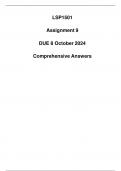Exam (elaborations)
LSP1501 Assignment 9 (Detailed Answers) Due 8 October 2024
Questions Assessment 9 This elective covers the entire content of the LSP1501 study guide. SECTION A: PERFORMING ARTS DR LE ROUX When we plan performing arts classes for the Foundation Phase, we can go to the internet to find ideas. What we need to teach and the outcomes the learners must ac...
[Show more]



